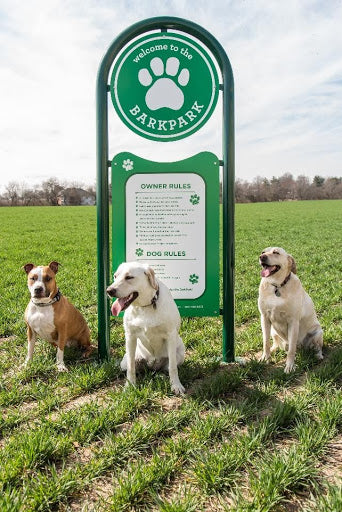Thinking ahead and considering long-term maintenance lead to successful dog park.
By Pet Pro Supply Co. Featured Expert,
MADELINE DOCK
SALES COORDINATOR AT PLAYCORE, OWNERS OF BARKPARK DOG PARK EQUIPMENT
This article is a part of a larger Pet Pro Supply Co. series on Dog Parks. See the list of articles below:
- Dog Parks: Great for Everyone, Not Just the Dogs
- How to Design a High-Quality Dog Park
- One Size Does NOT Fit All – Separate Spaces for Large and Small Dogs
- How to Maintain Your Dog Park
- Dog Park Safety Measures in the Age of COVID-19
- What Type of Surfacing Should I Use in a Dog Park?
- Buy Dog Park Equipment
Today, dog parks can be found across the globe. More and more, we're seeing them everywhere from traditional parks and recreational areas to multi-family housing to hotels, resorts, airports, and even rooftops. As you start your journey in creating an off-leash dog park, location and design are undoubtedly essential decisions to make. But, what aspects of a dog park make it a sustainable, popular attraction for years to come?
BarkPark's years of experience in dog parks show that the key to keeping your dog park flourishing is... maintenance!
Dog Park Sustainability Planning
Off-leash dog parks are a meaningful investment for the community and need to be treated as such by optimizing the park's life for as long as possible. The achievement of having a successful dog park will require planning and the commitment from both staff and the community towards maintenance.
For staff, keeping up with the day-to-day park maintenance, organizing cleanup crews and regularly scheduled maintenance inspections are all key to dog park longevity. Community cooperation will also be critical for the dog park's continued excellence; educating dog owners on the need to be responsible and adhering to the rules will help create overall cleanliness and enjoyment.
As with any public space, budgeting is also important. You'll want to plan a budget for the financial costs of maintenance. Planning the expense of long-term and short-term maintenance costs will help reduce many of the perceived problems associated with an off-leash dog park. Short-term weekly costs that need to be factored in include waste removal, lawn care, adequate sanitation of highly trafficked touchpoints, re-supplying disposable bags and filling holes that dogs may have dug up. Make sure to also think ahead and consider long-term maintenance costs such as replacing broken or weathered dog park equipment and repairing fencing and surfacing.
By establishing a budget, you now will have a baseline to set up a maintenance program to keep your dog park a safe, functional and clean environment for all.
Dog Park Inspection and Maintenance
The wear and tear of dogs and their playful habits are inevitable, so regularly scheduling maintenance inspections is vital to the longevity of your equipment and outdoor surfacing.
As with any dog park, the equipment is subject to the harsh outdoor elements; therefore, it must be inspected regularly. Two types of inspections should be occurring at all dog parks - low- and high-frequency inspections. The inspection frequency will be determined by keeping in mind the equipment age, the climate in which its located, usage frequency and materials.
Low-frequency inspections - should occur periodically or at least twice a year. This is a detailed inspection of the equipment in the dog park. You'll want to check for damaged parts, secure loose bolts, check for sharp edges, cracked material, and splintered wood in these planned in-depth inspections. If damage is found, the equipment should be replaced, or if the damage is repairable, it should be immediately fixed.
High-frequency inspections - should happen on a daily or weekly basis. Problems to look for are trash, pet waste, debris, grass overgrowth, vandalism, and weather damage. If any hazards are found, the staff should correct the problem immediately.
Frequent inspections might seem cumbersome, but with the proper routine and a timely maintenance response, you'll be able to help protect pets and pet owners from costly accidents and demonstrate the standard of care the community is willing to give to its users.
Maintenance Considerations:
- Tending to surfacing – filling holes and/or re-seeding grass
- Mowing grass
- Hand weeding / tending to landscaping (do not use toxic weed spray)
- Removing dog waste
- Spraying /hosing down equipment furnishings, trash receptacles
- Emptying trash receptacles
- Inspecting fencing for damage
- Tending to bacterial growth on fencing
- Inspecting gates and locking mechanisms
- Inspecting equipment and amenities – properly placed trash receptacles can help prevent litter at the site
When equipment is unusable, visitors miss the opportunity to get the full experience intended - and most importantly, may not want to visit again! Carefully maintained outdoor environments are a source of pride and are a direct reflection of community standards. Therefore, the standards you set in terms of cleanliness and the usability of all equipment is what will determine your dog park’s success and enjoyment for years to come.

About Madeline Dock:
Madeline is the Sales Coordinator for the National Accounts team at PlayCore. She works daily with customers all over the country to sell products across the entire PlayCore spectrum, including playgrounds, site amenities, dog parks, fitness parks, surfacing, aquatic products, shade & shelters, etc. Her favorite part of her job is providing solutions to help others connect and stay healthy, by assisting communities in building up their outdoor spaces. It's her way to leave a positive impact on communities across America.
SOURCE: PlayCore, Unleashed: Off-leash Dog Park Design Trends and Planning Tips, 2018

 Login
Login

